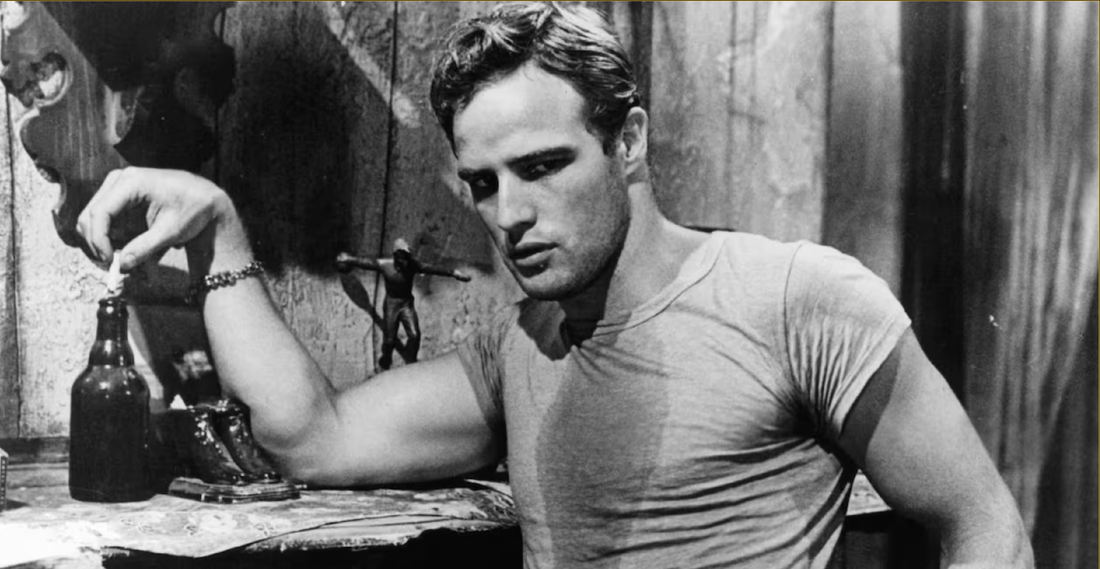
Finding Inspiration - Embodied Expression - A Dialogue Between Clothing and Culture
Share
A history and experience of culture that inspires me
Marlon Brando’s raw presence in A Streetcar Named Desire reshaped the way masculinity could be seen and embodied. That image - its tension between vulnerability and dominance, eroticism and aggression - continues to ripple through culture.
Brando’s style is more than costume; it is a language of attitude, a way of embodying presence that unsettles and seduces in equal measure. The simple white T-shirt clinging to his frame, the way he slouched or prowled across a room, spoke not only of physical strength but of a restless energy just beneath the surface. It was clothing made expressive through gesture, through the weight of his body, through the unspoken charge of his performance.
This has become a starting point in my own work: the idea that garments are never neutral, that they carry with them the possibility of power, vulnerability, desire, and resistance. Brando reminds me that style is lived, activated in the way fabric stretches, wrinkles, or sweats against the body. His image opened up new ways of thinking about masculinity, not as a fixed ideal, but as something volatile, performative, and charged with contradictions. These are the tensions I return to in my practice, exploring how clothing, stance, and attitude can reveal as much as they conceal.
Authenticity matters! For me my practice has roots in something personal, joyful memories, fetish gear and cultural, positive transformation of shame and oppression. I draw inspiration from places that celebrate raw, unfiltered self-expression: leather bars, underground club scene, vibrant queer art, fetish aesthetics, and the energy of those who refuse to blend in.
Growing up in London in the ‘60s and ‘70s shaped me, it was like living inside a whirlwind of rebellion, hedonism, and radical self-expression. The emergence of the free love hippie movement, the strange world of Flash Gordon, Batman and Robin, with their sexualised costume designs, and the dark tone of Blake 7, and the electrifying charge of the gay liberation movement in the ’70s all pulsed through the city’s veins. By the time the ’80s hit, the streets were alive with the underground throb of nightclubs, leather bars, and raw subcultures, nights on Hampstead Heath, street cruising and cottaging that refused to be tamed.
Artists like Tom of Finland, Harry Bush, and Robert Mapplethorpe, captured unapologetic sexuality in drawings and photography, while playwright Joe Orton’s razor-sharp wit cut through the conventions of the time. His stories, like Entertaining Mr. Sloane and Prick Up Your Ears, weren’t just plays; they were provocations, challenges to society’s prudish facade.
The soundtrack to this chaos? Frankie Goes to Hollywood blaring from club speakers. Madonna re-writing the rules of pop. George Michael making sex appeal political. And all around, tribes formed, each with their own armour. DIY punk gear clashed with slick Mod tailoring. Skinhead boot-boys stomped alongside leather-clad bikers. New Romantics blurred gender lines while football hooligans kicked off in the streets, and Chelsea’s Kings Road was the place to be seen. It was gritty, visceral, anarchic, a time when identity was fought for, not bought off a high-street rack. AIDS loomed, unemployment soared, miners’ strikes and uncollected rubbish piled up in the streets, yet London burned with creativity, sexuality, and defiance against operation spanner, and Thatcher’s attempt to repress homosexual education with clause 28.
Today, high streets are sanitised, CCTV watches every move, and mainstream fashion feels… predictable and soft compared to the leather jackets individuals wore in decades before. But the fire of those past movements, the boldness, the rawness, the spectacle, lives on in KYBOR. Every piece is a tribute to those who dared to be different, an invitation to wear your truth with pride.
After all, as Alexander McQueen once said: “I design for the individual, not for fashion.”
Mainstream fashion loves to play it safe. Beige, minimal, forgettable. Fashion is often seen as a surface-level industry, but at its core, it’s deeply personal. The clothes we wear send signals to the world about who we are. I want every person who wears a KYBOR piece to feel seen, celebrated, joyful, and confident.
Fashion isn’t only about looking good; it’s about culture and kudos, being confident and sending a message. And let’s be honest, most brands sell sanitised nice versions of culture. They dip a toe into boldness, then pull back before anyone gets uncomfortable. But the underground scenes that inspired KYBOR never did that.
My journey was inspiration by the raw energy of London’s underground scenes, unapologetic - leather-clad bikers, the DIY punks who turned safety pins into statements, and club kids who turned self-expression into an art form and blurred the lines between fantasy and reality, and the queer icons who made sexuality political and powerful.
The question is: what’s the boldest gear you’ve ever worn? Drop it in the comments!
Artist’s Note:
I use AI as part of my writing process, not to replace creativity, but to deepen it. Our conversations help me uncover language for what I feel, think, and see. The result is always my own voice, my story, and my ideas, shaped through dialogue. The idea that creation, like pleasure, is collaborative, performative, and alive.
